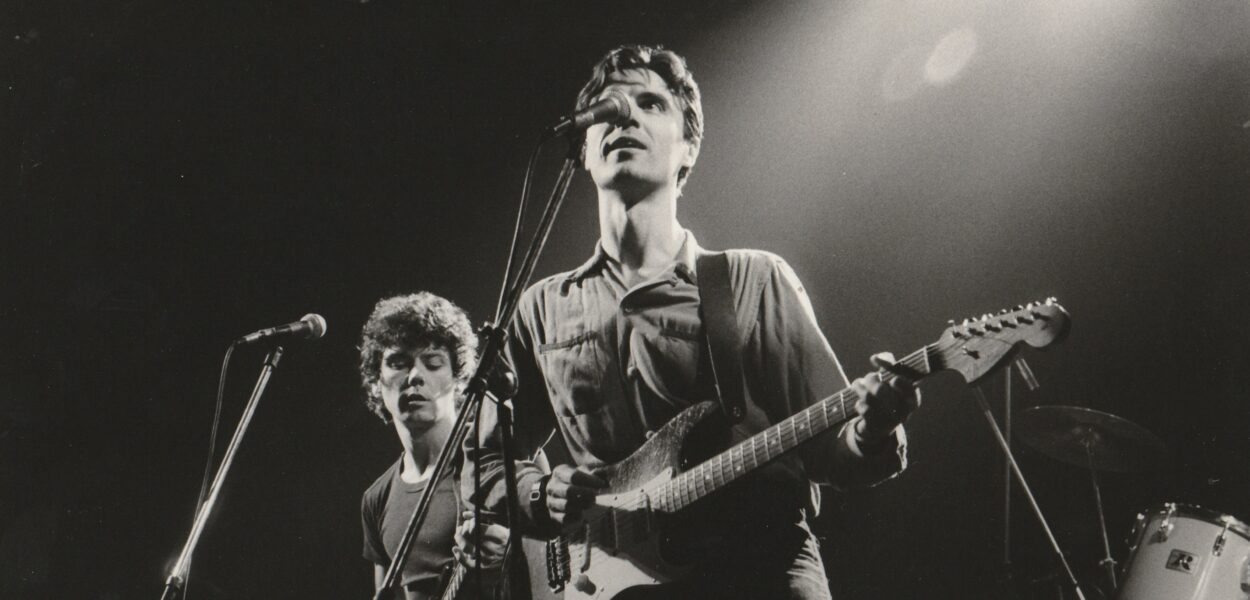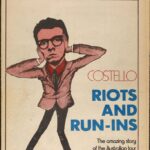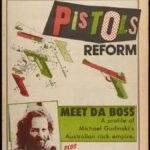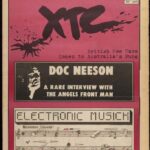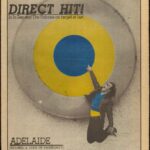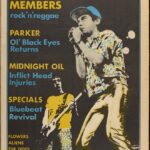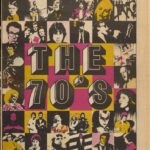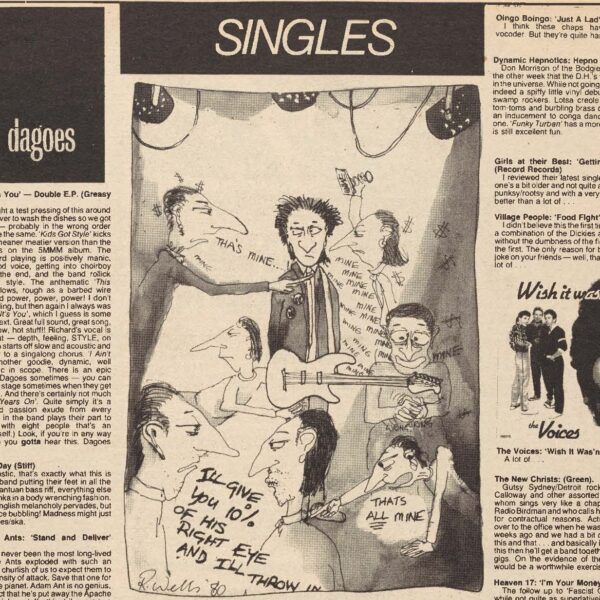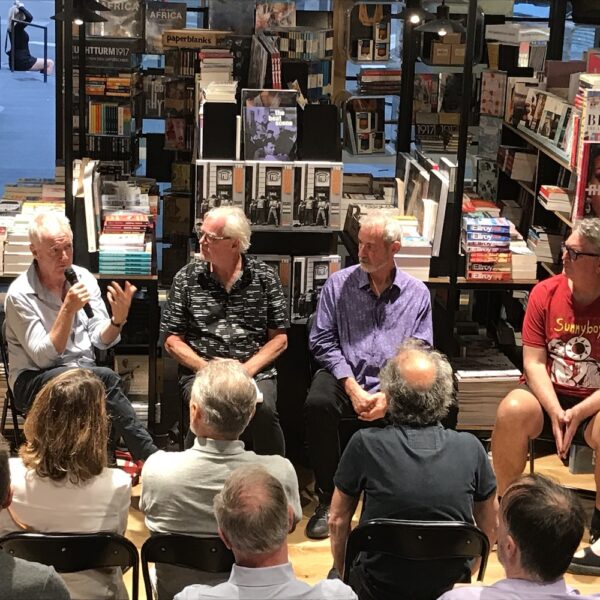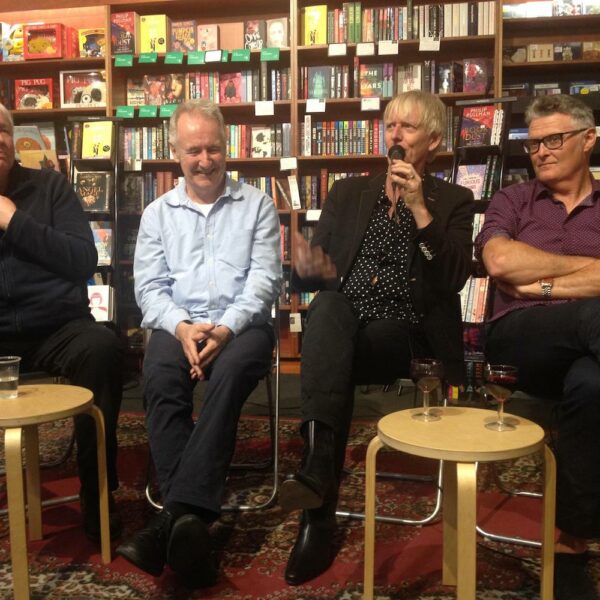To view and download issues, click on thumbnails below
- February 1979
- March 1979
- April 1979
- May 1979
- June 1979
- July 1979
- August 1979
- September 1979
- October 1979
- November 1979
- December 1979
Roadrunner’s first national issue hit the newsstands in February 1979. The cover story on the riots and run-ins of Elvis Costello’s summer tour was by the hard-hitting Ross Stapleton, whose fascination with the behind-the-scenes machinations of the music industry was to yield a series of lengthy features over the following twelve months. As well as being engrossing exposes in their own right, they had the effect of making Roadrunner a must-read for industry participants in the eastern states.
My indulgence of Ross’s tireless championing of The Angels—admittedly the country’s biggest drawing live band—in the year to come would, however, cause ructions amongst the magazine’s founders.
To help publicise Roadrunner‘s national launch, production editor Clive Dorman wrote the following piece, which he sent to various newspapers and magazines. It actually prompted a nice article by Stephen Hunter in Adelaide’s morning paper, the Advertiser. It sets the scene as I strapped in for what turned out to be a wild ride.
* * *
Australia’s rock aficionados this month get an extra option when they go to the newsstand to pick up the national rock press. From this month, there’s a third competitor in the field, pitting its weight against the Sydney-based RAM and the Melbourne-based Juke.
The new magazine is Roadrunner, from Adelaide—and it isn’t really all that new. The February issue is in fact the tenth Roadrunner, but it’s the first national one.
Roadrunner first appeared in Adelaide early last year, edited by Donald Robertson and Stuart Coupe (the latter now in Sydney with RAM) after their punk fanzine, Street Fever, wasn’t able to go on after its first issue. Robertson and Coupe, then joined by several others in an editorial and productive collective, soon began producing the broader-based Roadrunner.
During 1978, the collective struggled on, usually just managing to survive. It was scratching for advertising, largely unrecognised by many of the people, even in Adelaide, who it needed recognition from. Various diets of largely New Wave fare were tried, but by October the other editors had decided to give it away. Coupe had by this time quit and joined RAM.
Only Donald Robertson decided to continue. But he quickly managed to get a new team, including a number of professional journalists—something lacking previously in the Roadrunner editorial collective. He started commissioning articles and seeking out better quality pix. He streamlined the accounting side of the operation so the paper could start recovering more of the money it was owed by advertisers. Finally—he increased the print run.
The next step was an eastern states tour by production editor Clive Dorman late last year. He found a lot of enthusiasm in Sydney for Roadrunner, both in radio and record company circles. Wizard Records took out a full-page ad, testimony of their faith in the magazine. There was also a lot of interest generated in Melbourne, where one of the editorial collective members, Bruce Milne, continues to write for the paper. More advertising revenue came from Melbourne.
When Dorman returned from his trip, he and Robertson decided that the magazine really needed to go national. There was, really, no way back to the struggling Adelaide-based paper which sent perhaps one hundred copies of each issue to Sydney and Melbourne as curios. They decided to take the risk of attempting to produce a national newspaper from Adelaide.
Roadrunner, in case you’re wondering, doesn’t take its name from the bird that consistently beguiles Wile E. Coyote and foils the ACME Company. It’s the title of a song by Jonathan Richman, a Boston New Waver, all about Living in The Modern World, and driving to the stop and shop with the radio on. Robertson chose the name for the philosophical reason that he and the others liked it.
The first national edition has emerged with ‘Australia’s Independent Music Paper’ under the masthead, and it’s certainly going to have to create some form of dedicated readership around this or some other concept to succeed. RAM and Juke—each boasting much bigger circulations than the newcomer—are well placed to squeeze.
But if the first edition is anything to go by, perhaps there is room for optimism for Roadrunner. It certainly does seem more heavyweight or ‘quality’-orientated than its two competitors, with a much cleaner appearance. But does Australia have room for a music paper that won’t tell the fans about what Rod Stewart’s doing after his concerts and what Leif Garrett does when he gets tired of skateboarding?
In this regard, Roadrunner runs up against all the same old questions of demand that any aspirant quality press finds constantly asked in Australia. Or to put it another way, if the masses want newspapers with girly shots on page three, what are your chances of survival if you don’t print them and put something else there? Can an Australian rock music paper survive without John Travolta and Olivia Newton-John?
Well, if the first national edition, with its eleven thousand print run, fifty cents each, distributed in all states except Tasmania, is anything to go by … the answer could well be yes. Although the lead story has been reported elsewhere, Melbourne freelance Ross Stapleton has gone much deeper into the riots and run-ins of that bizarre concert tour. There’s also a good article on The Sports, the Melbourne band most-likely-to when they head off to Britain soon. An interesting piece that could only appear in Roadrunner is about the record industry itself—and how Adelaide has a huge record plant that won’t touch rock. There are also pieces from correspondents in Britain and the USA. No reprints.
* * *
In January 1979, Dorman wrote to Michael Finucan at community radio station 4ZZZ asking if he was interested in writing about what was happening in Brisbane. Dorman was upfront about the magazine’s financial situation. ‘We’re poor as hell and will be so until the cheques for national sales start coming in, in about three months’ time. However, we think we’ll be able to start paying writers at least something to grumble about mid-year.’
The magazine had begun with no capital and no investors, and 12 months on went national with a print run of 11,000, a cover price of 50 cents—and still no capital and no investors. As Bob Dylan wrote, ‘When you ain’t got nothing, you got nothing to lose.’
Bridge Press agreed to print the magazine on credit for a few issues, while enough ad revenue was coming in to cover other production costs, pay my rent and put food on the table. Michael Zerman introduced me to a groovy bank manager, Phillip Virgo, at the King William Street branch of the Commercial Banking Company of Sydney, who agreed to extend the magazine a small overdraft against future sales receipts.
Production moved to Geoffrey Gifford’s studio in Glen Osmond Road, Eastwood, near iconic rock venue the Arkaba. Gifford recalls Dorman arriving at the door one day with a huge phototypesetting machine, which he proceeded to install. As Gifford was also living at the premises, this was rather an imposition, but being the cultured soul he is, his protests were polite, muted and, well, ineffectual. The magazine promptly set up camp in his living room.
A new routine evolved. Bridge Press provided printed layout sheets, and Gifford and his offsider, Trudy Hayter, would paste down the strips of type coming out of Dorman’s machine, plus the headlines, the halftone bromides of photos, captions, and page numbers, while Gifford would weave magic with spot colour screens on the cover and centrespread. The day before print deadline usually involved myself and the crew staying up all night to complete the artwork then, as the sun rose, jumping in someone’s car (I didn’t have one and in fact didn’t even have a licence) and motoring the 75 km up the South Eastern freeway to Murray Bridge.
Once at Bridge Press, I would hand the artwork over to Adrian Dibben, the printer. Dibben was a taciturn Aussie bloke, in his thirties, who always seemed faintly amused at the artistic covers we tried to create. But he was an excellent printer and invariably rose to any challenge we threw his way.
I was fascinated by the printing process and would watch intently as Dibben made negatives of the pages, then joined four negatives to make the thin metal plates that were strapped onto the cylinders of the two-unit Goss Community web offset press. Coloured inks were added to the unit that was doing the spot colours, black ink to the rest, the large paper rolls were connected and, when everything was in place, Dibben pressed the go button. When the first few complete copies came out the end, he would stop the press, check the output, give me a copy for any comments and, if all was well, away the machines went again.
The binding machine spat out bundles of 100, which on a print run of 11,000 meant there were 110 bundles. I, with whoever had accompanied me that day, loaded the 40 bundles for Sydney into their car and drove them the 250 metres from the printer on Seventh Street to the Murray Bridge railway station, unloaded, labelled, and booked them in as freight. Then back to the printer for the 35 bundles for Melbourne, back to the station, then back to the printer to pick up the rest (Adelaide, Brisbane, Perth, subscriptions, contributors and freebies). Then an hour’s drive back to Adelaide where I would collapse into bed. Hands-on? You betcha.
Contributors were enthusiastic, with Keith Shadwick writing in February that the December 1978 issue with Joe Camilleri on the cover was ‘fucking good—keep it up!’ and Ross Stapleton saying February 1979 was about a ‘200 per cent improvement’ on the previous one. Stapleton went on:
‘I don’t think you are far off achieving the sort of excellence you should be aiming for. There’s still a way to go but, by god, you’ve already covered most of the distance, the touchdown shouldn’t be nearly so difficult now. I don’t think the content can greatly improve, but visually I think that’s the area for the most concern. I’ll give you 7 out of 10. Keep up the great work.’
For the second national issue (March) the cover story was from Brian Johnstone, an AAP journalist who I’d met through my housemate Larry Buttrose. Johnstone, who had previously contributed some well-researched articles about the state of the music industry in Adelaide, chipped in the tasty tale of the confected media outrage surrounding The Stranglers’ tour of Australia—not Mike Willesee or Molly Meldrum’s finest hour. The issue also featured part one of Stapleton’s expose of agency manoeuvres in the live music business, which recounted some of the skirmishes resulting from the challenge newcomers Dirty Pool were making to the might of Michael Gudinski’s Premier-Harbour group.
After submitting his magnum opus about The Sports’ tour of the UK, Keith Shadwick in London was positive things were going in the right direction.
‘The real advantage of Roadrunner I think over Juke and RAM is good articles, in-depth studies, sensible reviews overall and their (sic) own overseas correspondents. RAM just reprints Melody Maker stuff etc etc. You agree?’
Well, yes.
Bob Marley’s Sydney press conference was dominated by 2JJ’s Tom Zelinka, and for good reason, according to Stuart Matchett. ‘Tom’s knowledge and enthusiasm for reggae is unequalled in Australia,’ Matchett wrote in his introduction to the May issue centrespread, which was tastefully decorated with green ganja leaves. We printed the entire press conference together with some concert snaps from Eric Algra.
Stapleton delivered a forensic account of Gudinski’s vertically integrated music empire in the same issue and followed up with a cover story on The Angels in June. Some of the magazine’s founders were not impressed with the latter. Bruce Milne, who had succeeded Clinton Walker as Melbourne editor, wrote to me.
‘We are without any direction at all. As I understand it (and I’m saying this after discussions with Stuart, Clint and Peter Bakowski) we are supposed to be covering the new bands and offering the sort of down-to-ground stuff you won’t find in the other magazines. We don’t need to compete with the other magazines. So why are 4 of our 12 pages of articles devoted to The Angels? … I’d like to know what R/R wants so I can decide whether I want to write for it.’
Oh dear. Growing pains. Was Roadrunner going to remain alternative or go mainstream? Was it going to stay ‘credible’ or sell out?
As far as I can recall, I wanted both. I wanted to cover the up-and-coming bands and the new music but I also wanted to sell more copies and if that meant putting The Angels on the cover, then that was absolutely fine.
And we needed to sell more copies and more ads because the patience of some of our penniless contributors was beginning to wear thin.
Shadwick wrote from London outlining his parlous financial state and seeking a monthly retainer.
‘I do really want to keep our good working relationship because I believe very much in you & in the magazine as a whole. I will need some money soon, however, to make ends meet. Can you dig it?’
Clinton Walker did a cover story on Electronic Musick for July and when it came out he wrote saying he was most ‘most impressed’ and had a ‘rejuvenated interest’ in Roadrunner. But he was also facing hard times in Melbourne.
‘What else? Well, money. I don’t mind so much about not getting any (of course I’d love to though), but it is very hard for me to keep taking pix without some sort of financial support. It’s pretty hard taking pix on the dole’s $50 a week—for instance, I’m forking out $10 for some prints today and they’re going to you, and $10 away in one go really fucks my finances. I’d appreciate some money just to cover my costs.’
Jillian Burt had been involved from the magazine’s very early days. She had relocated to Melbourne where she was still a contributor and gave a mixed review of the July issue.
‘The Angels interview (again) was a bit unnecessary. Doc Neeson didn’t say much or say it well. There has been heaps of criticism of The Angels by lots of people: that they’re derivative, contrived etc. How about a piece on The Angels that presents that view?
‘Clinton’s electronics are spot on and his Sydney bit delightful. The creatively obnoxious John McLaughlin bit was an absolute pleasure to read after all the holier-than-all stuff that’s been printed about him. It was like it was the second bloody coming, or so the promoters would have us believing.’
The news was better from New South Wales. After packing his bags for Sydney, Coupe had hit the ground running but after 12 months at RAM, he had an argument with the esteemed Anthony O’Grady (over the length of a Redgum album review, I understand) and David Dale hired him to write a rock column for the Sun-Herald. The move also enabled Coupe to join forces with Stuart Matchett to create a Sydney dream team for Roadrunner.
Subscriptions were one way to get sales money up front and I managed to sweeten the offer with Roadrunner T-shirts. In July 1979 a year’s subscription was $8; with T-shirt added, $10. This sometimes put those on the front line in some peril.
Matchett wrote from Sydney.
‘There I was at the Bondi Lifesaver watching Sports when this woman said, “Hey, fuckhead! Where’s my Roadrunner?”
it turned out I knew her—her name is Margaret Wertheim (I think)
she lives in Brisbane (I don’t know
and claims to have sent off money for a subscription and hasn’t seen a copy yet. Just thought I’d let you know.’
Margaret’s subscription was promptly attended to; I can assure you.
* * *
In my July 1979 newsletter to contributors I brought people up to date with the magazine’s advertising, distribution and general financial situation.
‘Money. We have managed to knock $1000 off our print bill due to a concerted effort by Michael Zerman here in Adelaide, Bruce Milne in Melbourne and Stuart Coupe in Sydney. But we’re not out of the woods yet. We are going to have to pay $1000 a month to the printer if the paper is to continue. That shouldn’t be too hard as the big record companies have at last decide to come to the party. We have signed a 12-month advertising contract with Festival for one full page per issue which is going to be a help, but realistically we need about six pages of ads per issue if we are going to be able to pay everyone for what they write. If you have any good ideas for advertising, contact Bruce Milne in Melbourne or Stuart Coupe in Sydney. We pay 20% commission for each ad when the ad is paid for (we have quite a lot of difficulty extracting the moola from certain of our advertisers) so if you can get the money pre-paid we get our money and you get yours, and everyone is happy.
‘Distribution. Is still not good, particularly in Victoria. It’s OK in N.S.W. and not TOO bad in S.A. Scott Matheson is distributing in Qld. again as President Distributors fell through. White Rider Records are distributing in Perth. We are currently talking to Conspress who distribute Women’s Weekly and Rolling Stone about the possibility of them distributing us nationwide, which would solve most of our distribution problems, I think. There’s nothing definite yet but it is a possibility.’
Shadwick finally lost patience and gave me a blast in his letter of 10 July.
‘I’m really pissed off with what’s been happening, or rather not happening as well. What happened to the retainer? For three weeks I relied on the money coming and it didn’t—it left me up shit creek financially and now it’s too late to get a temporary job as all the uni students have snapped them up. As you can see from the article I’ve enclosed, I’ve kept faith, deciding this can all be worked out in due time but for god’s sake let me know one way of the other, please.’
My August letter to contributors explained the magazine’s situation.
‘Yup, Roadrunner has managed to keep the wolves from the door for another month. I reckon I should change the name of the mag to Houdini Weekly. The problem with the paper is not that it’s not selling enough copies or getting enough ads. It’s that the people who distribute the paper and the companies who advertise in it are taking an inordinately long time to pay the money that they owe. In business terms this is known as a cash-flow problem, I am told. The problem is compounded by the fact that the bulk of the paper’s revenue is located in Victoria and especially NSW. This means that I can’t just pop around to CBS/EMI/Festival and set up camp until the cheque for advertising is forthcoming. In fact, if production costs were not so cheap here in Adelaide, I would move the paper to Sydney tomorrow. I am thinking of moving it anyway, but am waiting on some production estimates from Stuart Coupe.’
The ‘brand spanking new’ advertising rate card offered the following pitch to advertisers.
‘Roadrunner is a monthly music magazine published in Adelaide and distributed throughout Australia. It provides in-depth coverage of the Australian music scene through its network of correspondents in all capital cities plus on-the-spot reports from writers overseas. The paper also includes a comprehensive review section which covers the latest album and single releases plus current films and books. Roadrunner has a distinctly Australian flavour for the simple reason that all articles and reviews are original, not reprinted from overseas magazines. If you are part of Australia’s ever growing music scene, then Roadrunner is your paper.’
The cost of a full-page ad was $280, half page $180. Inexcusably, no circulation or readership figures were included. Doh!
Coupe sent me his thoughts about a proposed move to Sydney. In his considered opinion it was not a good idea. He felt the three important things were a regular contributors fee (‘Even if it’s small it should be for all’); increased circulation in Sydney (‘Have you suggested to Allan Rodney Wright that they flood shops with it?’) and sometime go fortnightly. ‘Given all this I realise you’re probably working your arse off just to keep things going,’ he conceded. And he was right! He said:
‘My feelings are the other three things are more important than sacrificing what appears to be an established production cycle—I’ll check but costs will skyrocket up here—no-one typesets for Clive’s price and no-one will print for anywhere (near) that money plus you’ve got the problem of finding more staff and let’s face it what extra could be done up here that you couldn’t do in Ad(elaide) or have me do here???????? … You really won’t get any closer to the higher echelons of record companies and the further you go up the worse they are—believe me, hanging around record companies is one big drag—they’ll all be your friends superficially but that’s because they want things—it’s so nauseatingly insincere up here—the good thing about Adelaide is that you’re filtered from the bullshit …
‘I think the mag is at a crucial stage and if you keep up the present rate of work for another six months you’ll be here to stay for as long as you like. Although a move to Sydney might be good then, I think things would be thrown into chaos at this crucial time—my advice is get really established, get yourself a decent income equal to all the work you’re doing, start paying contributors, give me more to do, try to keep in closer contact and things’ll be great—what do ya think?
‘Anyway I better post this—keep it up—the paper gets better every issue and it’s important to keep it going, even if you’re bored shitless in Adelaide. Sydney has even more deadshits and most of them work in the music business …’
I wrote to Shadwick in London explaining the situation and he replied with the news that with the assistance of a somewhat exaggerated reference from Roadrunner, he had landed a position as editor of Music Trades International, at a salary of £5500 a year plus a company car. ‘It won’t interfere with writing for Roadrunner,’ he assured me. ‘In fact it’ll help because I’ll then have a car, and can go to a lot more gigs at night and out-of-town things.’
The communication from Melbourne was not so positive. In August, contributor Jillian Burt unloaded on the August issue, saying it ‘has almost no redeeming features. You want criticism and comments, so here they are.’
Burt didn’t miss. Malicious Gossip was ‘overly smartarse and carelessly written and cumbersome to read’. Coupe’s Jo Zep piece was ‘careless, gluggy and of no substance at all’. Keri Phillips’s interview with English rock journalists Tony Parsons and Julie Burchill of the New Musical Express was an ‘in media wank’. The Young Modern story needed ‘more of them, less of Stuart [Coupe]’. The Angels? ‘How tiresome, tedious, overdone. More Angels by Ross Stapleton, even more odious. It was an utter waste of space.’ She concluded:
‘Roadrunner as a whole is an in-joke, a slightly left-of-mainstream Juke. You are cast as the benevolent puppet of the record companies. The paper is out of touch, has lost its impartiality and capacity for criticism. With the tendency to cuddle up to hype so easily, Roadrunner simpers not barks.
‘I donated articles and assistance to Roadrunner because I believed in the notion of a smart paper that concentrated on the small Australian bands without being afraid to step on record company toes. I believed Roadrunner to be a paper with foresight and objectivity; that it is not. I’m bitterly disappointed with your lack of regard for the contributors, financially and otherwise. I’m consequently relinquishing any association I have with Roadrunner. Prove me wrong, make Roadrunner worthwhile.’
Ouch.
* * *
In my September newsletter to contributors I announced that Rob James had joined the paper, and would be handling administration and financial matters.
‘Rob used to work on an Adelaide mag called Magnetic Tadpole, and has a long and murky record in enterprises of this type. He is in Melbourne at the moment trying to sort out the paper’s affairs over there (particularly the distribution).’ I also mentioned that Toby Creswell and Richard McGregor (Rolling Stone) had started writing for the paper.
One of the first things James did was organise a contra deal through Ogilvy & Mather (Australia) with the coach company Ansett Pioneer. The deal was five free Adelaide-Sydney return tickets for a full-page ad. This enabled me to get up to Sydney, meet key contributors like Matchett, nail down some advertising contracts with record companies (including with Philip Mortlock at WEA and Martin Fabinyi at Regular Records), and generally hang out and network for a week or so in the buzzing Sydney scene.
We put together a benefit concert for the magazine in Adelaide—two local bands, Lemmy Caution and The U-Bombs donated their services, and we brought Boys Next Door over from Melbourne as headliners. Held at the Burnside Town Hall on 28 September, it was a mild success.
On the Melbourne front, Bruce Milne tendered his resignation as Melbourne editor on 2 October. He wrote:
‘Not because of any great grudges or bullshit like that but because—
a) I’m not interested enough in the job and consequently aren’t committed enough
b) My involvement with other things makes it slightly unethical
c) I’m just too busy at present.
‘So my stand is—I’ll help in any way I can, I’ll remain a contributor, and aid you whenever necessary. OK?’
OK.
Milne followed up in November.
‘I’ve heard about the financial problems and I’m worried. I’m concerned firstly because I realize it’s a business with your name so that debts (ultimately) fall on your head. I’m also concerned because Roadrunner must continue. There is a huge need for it and despite any differences between us I don’t ever want to see it fail.
‘I have some suggestions:
‘1) A benefit concert in Melbourne. Stuart mentioned to me plans for one in Sydney. I’m sure I could organise one at the Crystal Ballroom early next year.
2) Roadrunner is still not reaching Melbourne shops. If you’ll give me the same cut as Melbourne W/salers I’ll distribute to the import shops.
3) Clint, Phil Brophy and I are bringing out a booklet of the complete Oz New Wave discography. Really complete—titles, catalogues, photos, studios used, producers, # pressed, release dates etc . When we’ve got it printed (Jan) and know how much it will cost, you’re welcome to sell copies thru the mag and make a retailer’s profit.
‘I can’t stress enough that I want to see Roadrunner continue and will help if I’m needed. You’re always welcome to stay if you’re in town.’
At the suggestion of Moira Manos, the new head of Virgin Records Australia, I sent some copies of the mag to her brother-in-law, Chris Salewicz, a staff writer at New Musical Express in London. Chris wrote back in November and offered to do a ‘monthly think piece—with all relevant quotes—about what’s going on in London’. This didn’t eventuate, but he did contribute some impressive feature articles in the years to come.
In November, Geoffrey Gifford moved out of 133A Glen Osmond Road to a studio at 240 Rundle Street in the city, leaving the premises to Neighbourhood Typesetting, Clive Dorman’s business. The Roadrunner office also moved out—to the front room of Robbie James’s house in Porter Street, Parkside.
The last four issues of 1979 contained some real highlights. The Knack/B52s/Sports cover in September was smart and cheeky. Gifford’s ‘Powerpop’ cover for October was arty and classy—and the centrespread on Mental as Anything looked superb. The cover for November (a live shot of British rock’n’reggae band The Members) wasn’t outstanding, but the double issue celebrating the end of the seventies was far and away the best the magazine had yet produced.
I don’t recall whether it was Ray Hearn and John Woodruff of Dirty Pool (the Sydney management agency that handled The Angels, Cold Chisel and Flowers) or Chris Gunn (who managed Adelaide politico-folkies Redgum) who introduced me to Phil Gerlach of G & S Management Services. Whoever it was, the referral was very welcome, and Roadrunner appointed G & S as accountants, and financial and management consultants in January 1980. Apart from doing the books properly, G & S, with its aura of respectability, was invaluable in negotiating an ongoing relationship with Bridge Press. This involved paying for each issue up front and knocking a bit off the accumulated debt every month—a satisfactory situation for both parties.
I wrote to contributors in January on my newly acquired, second-hand Olivetti portable typewriter.
‘Well, friends, the ’80s start here. Contrary to what you may have heard (if you haven’t, don’t worry about it) Roadrunner has not curled up and died. Financially things are tight (when haven’t they been?) particularly due to the extra expenditure involved in putting out the double issue, but with everything else looking so promising, I certainly don’t feel that it’s time to throw in the towel.
‘The reaction to the double issue has been most heartening. That is the standard of layout and design that all future editions must be judged on. The quality of the writing has always been excellent but finally I think we achieved a visual style that was commensurate with it. I would like to thank you all for your contributions and I hope I can count on your continuing support for the year ahead.
‘To raise some much needed capital for the paper we have decided to put on benefits in Melbourne and Sydney. The Melbourne one is arranged for the 27th January at the Crystal Ballroom and will feature three top bands (details TBA).
‘Roadrunner has always been undercapitalised. In fact, apart from a loan from Stuart Matchett early last year, the paper has survived on the money it has made from advertising and sales. Hopefully the money we make from these benefits will put us on a solid financial base. As you probably know, there is a considerable delay between putting an issue out and receiving sales money for it. With a monthly paper like RR it’s about two-and-a-half months. If we had all the money from copies that we’ve sold we’d be fine.
‘Partly to speed up this process and partly to effectively compete with RAM, Juke and Rolling Stone, I have decided to publish the paper fortnightly from the first issue in February. I estimate that by the end of March the increased revenue from this move will enable us to pay contributors at the rate of $20 per thousand words. Payment has been a long time coming, but coming it is.
‘Another development that is going to increase our sales is the soon to be signed agreement with the Herald and Weekly Times for distribution in Victoria and Queensland. The agreement has been drawn up and sent to H & W T and we are just awaiting their formal approval.’
It seemed Roadrunner could look forward to the eighties with some optimism.
However, as the old proverb says, there’s many a slip ‘twixt cup and lip.


